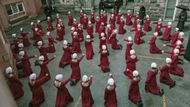We’ve always loved The Handmaid’s Tale. It’s a classic. Margaret Atwood’s novel, first published in 1985, is one of those powerful stories that stick with you. When the TV series came out on Hulu in 2017, it introduced a dystopian world to a whole new audience. It also got people talking again—about the characters, the world of Gilead, and what it all means.
Although the show remains fairly faithful to the book, both in terms of story and tone, it does make some significant changes. Some of them are big and obvious. Some are small but significant. And these changes aren't merely for appearances. They show us how things have evolved in the world since the book was published—how we think about power, identity, women's rights, and storytelling itself.
So, let's discuss those changes. What did the show change, omit, or reimagine? And what do those changes reveal about how we perceive The Handmaid's Tale today?
The Handmaid’s Tale: Book vs show
Names have power: Identity and disappearance

Offred's name: Who is she, really?
One of the biggest differences between the book and the show is what happens with Offred’s real name.
In the book, Margaret Atwood never confirms what it is. There’s a scene where another Handmaid whispers “June” during a roll call, but it’s unclear if that’s actually her name. And that mystery is on purpose. It shows us how Gilead strips away your identity. Offred doesn’t even get to hold onto her name.
The series goes a different way. It informs us immediately—she is named June. We learn that in episode one. It might seem minor, but it alters the tone. It makes June more of a person from the very start. Someone with a history, a self, a rebellious spark that cannot be eradicated entirely. By giving her a name this soon, the show redistributes the emphasis.
The Handmaid’s Tale, hence, resonates with contemporary audiences who crave strong, distinct female protagonists. But it also tempers some of the book's message about how perilous it is when a system erases your name and your sense of self.
"Of-Fred" and the power of naming
Both in the novel and the TV series, Handmaids receive patronymic names—"Of-Fred," "Ofwarren," etc.—which means that they're named after their owners, i.e., the men who "own" them. This is a very frightening representation of how Handmaids are treated like property rather than human beings.
But the show places a visual spin. It provides the Handmaids with small metal tags on their ears—beware, cattle tags. That small alteration conveys so much. It reminds you that in Gilead, these women are observed, branded, and treated like livestock. The novel employs words to make you feel that way. The show shows it to you immediately.
Characters: How age, action, and motivation change in the show

June: Quiet survivor or brave rebel?
In the book, Offred is reserved and prudent. She's not fighting a revolution—she's merely trying to survive, remember herself, and retain hope. Her revolt is within. She resists by recalling, thinking, and telling her story.
However, the show offers us a rather different June. Here, she's a rebel. She is a risk-taker, a bold decision-maker, and a leader in the resistance. It makes sense for television—it creates tension, action, and dramatic moments.
But it also squares with how feminism has evolved. We no longer just want our heroines to imagine fighting back; we want them to fight back aloud.
Commander Fred and Serena Joy
In the novel, the Commander is older and somewhat melancholy. He's in the system, but not necessarily always in command of it. We don't even know his last name—only "Fred," from "Of-Fred."
In the show, he's Commander Fred Waterford. He's younger, smoother, and obviously more in control. That makes the dynamic between him and June more deadly.
And Serena Joy? She's totally different. In the novel, she's older, bitter, and frail. She's a shadow of the past—a woman who contributed to the creation of this system and now suffers the backlash.
On the show, she's younger and more active. Her conflict is more immediate and emotional, particularly regarding her inability to conceive. This shift brings more drama but also more depth. Serena becomes a character we pity at times, fear at times, and even empathize with at times.
Visuals speak loudly: Costumes, symbols, and surveillance

What people wear tells a story
In the novel, Handmaids wear red, the color of blood and fertility. The show makes that a full visual system. Handmaids wear red. Wives wear blue. Marthas wears green. Each color indicates your position. You can't escape it. The visuals tell many stories on their own and make us immediately understand how society is arranged and controlled in Gilead.
Tags, cameras, and control
The show does something clever by adding ear tags to the Handmaids. This isn't merely a creepy touch—it's actually related to the surveillance theme. Gilead isn't merely interested in dominating these women—it's interested in keeping track of them, identifying them, and ensuring that they never lose sight of who is truly in charge.
Janine's eye: A brutal reminder
In The Handmaid’s Tale, Janine is punished, but not fully explained—she's hurt, but she can still walk. In the series, the punishment is horrific and clear: she loses an eye. Whenever we see her, we're reminded of what Gilead does to women who don't obey. It makes the terror more visceral and persistent.
Diversity and representation in The Handmaid’s Tale: Expanding the story

Race and inclusion
The book does not focus a lot on race. It suggests Black people, referred to as the "Children of Ham," are being moved around, but the world is predominantly white. The series does something different. It casts Black actors in lead roles, such as Moira and Luke, and depicts a more racially diverse Gilead. This grounds the narrative in what's more relatable to real-world issues. It brings the story into the contemporary era, where race and representation are more prominent than ever.
LGBTQ+ characters and themes
The Handmaid’s Tale teases how LGBTQ+ individuals are treated in Gilead. But the series puts that center stage. We learn Moira's entire narrative as a queer woman. We become familiar with other LGBTQ+ characters. And we get a better glimpse of how Gilead punishes individuals for who they are. Those revelations make the world of the show even richer—and hurtful.
How the story is told in The Handmaid’s Tale: Book vs. screen

Narration and point of view
The Handmaid’s Tale is told from Offred's perspective. We're only given what she knows. And how she relates her story is fragmented, passionate, and unsure. That's all part of what makes the book so haunting—you're locked into her head.
The show can't do that precisely. It must depict other characters and things to create the world. So, it's a more omniscient story. That allows us to know more, but it also pulls away a bit from the intimacy of the book, the feeling of being closed in.
Voiceovers: What June tells us
To maintain some personal tone, voice-overs are employed in the show. We are made aware of June's thoughts. But they're typically harder and more assertive than Offred's subdued thoughts in the novel. Again, it suits the show's version of June: less passive, more powerful.
Plot shifts in The Handmaid’s Tale: What was added, what was changed

Pregnancy and motherhood in The Handmaid’s Tale
In the novel, Offred believes she is pregnant, but we never actually know. That is left up to us to decide, which is also how little power women have over their own bodies in Gilead.
The series does that differently. It makes use of a pregnancy test, and it verifies that June is pregnant. That raises the stakes and provides her with even more reasons to resist. However, it also reduces some of the novel's more complex concepts regarding fear, hope, and agency.
Jezebel's: More than a secret
Jezebel's—a clandestine brothel for Gilead's ruling class—is present in both the book and the series. But the series elaborates on it. We get to know more about the women who work there. We find out more about how it works. This makes Gilead's hypocrisy even clearer: they present themselves as being moral, but the rules apply only to some.
The resistance: From background to action
In the novel, the "Mayday" resistance group is spoken of, but Offred doesn't directly participate. Things occur around her, not due to her. In the television series, June is a full-fledged resistance leader. She plots, acts, and battles. This adaptation makes sense for the TV version of the story—less about living under the radar and more about rebellion.
The ending in The Handmaid’s Tale: Open or ongoing
The Handmaid’s Tale ends on a cliffhanger. Offred is carted off in a van—but we don't know whether it's rescue or arrest. Later, in a section titled "Historical Notes," we read that her story was discovered on cassette tapes and reconstructed by male historians, years after Gilead collapsed. That's chilling. It reveals how women's stories can be lost or treated as objects of scholarship.
The show doesn't end there. It continues after the book's conclusion. We see June's subsequent actions and visit more of Gilead's realm. That provides audiences with an additional story but also removes the book's haunting doubt.
What the show leaves out: Quiet resistance and missing voices

Inner battles are the toughest to depict
The Handmaid’s Tale is packed with Offred's inner thoughts—her fears, doubts, and memories. That sort of quiet defiance doesn't always translate onto television. So, the show tends to go for more overt, dramatic scenes. That is effective on television, but it loses some of the subtle force of the book's inner life.
The historical notes: A missed opportunity (so far)
That last segment of the book, where male scholars speak about Offred's tapes, is disturbing. It illustrates how quickly women's narratives can be erased, corrupted, or removed from their control. As of today, the series hasn't incorporated this. If it ever does, it might provide us with an entirely new level of understanding.
Keeping things uncertain
Atwood doesn't tell us everything. She leaves things unanswered. That's part of the reason The Handmaid’s Tale is so haunting and realistic. The show, in providing us with more plot and resolution, takes some of that mystery away. It's good TV, but less open-ended.
